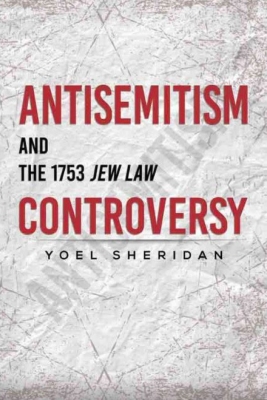Antisemitism and the 1753 Jew Law Controversy
Antisemitism and the 1753 Jew Law Controversy
By Yoel Sheridan
Austin Macauley Publishers, London, Cambridge, New York, and Sharjah
Paperback: $8.95, Kindle $4.50, both on Amazon
Yoel Sheridan's overt agenda when he began writing this slender (100 p.) historical volume was to explain a somewhat bizarre event in Britain's legal history: The passing of the Jewish Naturalization Act in June 1753 and its subsequent repeal, six months later, in December 1753. Just recalling the Act's derisive nickname (the Jew Bill or Jew Law) immediately tags it as just another episode in the history of European antisemitism, or a fluke in England's parliamentary annals, a footnote implying that Britain antisemitism lasted only as long as the Act was on the books.
But Sheridan, on his part, was dissatisfied with either of these interpretations. His review of the literature showed that little had been written about the Act's passage and even less about why it was at all proposed. He therefore set out to "follow the story", both backwards and forwards. I, personally, am very glad that he did.
In his search for why this incident unfolded as it did, Sheridan concludes that antisemitism, with its long-term and entrenched presence in British culture, was being used to further the interests of various powerful interest groups intent on undermining the Crown as well as Parliament. The rise and fall of the Jewish Naturalization Act therefore encapsulated several overlapping dramas thanks to historical events but also a shared rhetoric, which he identified in the protocols of parliamentary debates and the pamphlets written to spread propaganda, pro and con, for the purposes of influencing public opinion. He also explains why he rejects the interpretations of some leading scholars in the field.
In this respect, Sheridan combines the talents of an academic with those of a publicist. He doesn't weigh down the reader with too many details about the laws, regulations, and conflicts that kept antisemitism alive during the 500 years leading up the Act's passage. when the King and Parliament could decide whether or not a Jewish presence in England was permissible. To get a feeling for his achievement, I will telegraphically sketch what happened and what is covered in the book.
Timeline:
1144: The first case of blood libel following murder of a Christian child for the purpose of using his blood to produce Passover matzot.
1290: The Jews are officially expelled from England.
1534: Henry VIII renounces the Catholic Church and establishes the Church of England, a form of Protestantism.
1655: Oliver Cromwell tacitly allows Jews to return to England.
1689: Bill of Rights passed that shifted significant power to Parliament, reducing the Monarch's power.
1745: Defeat of the Jacobite Uprising (attempt to return Scotland's King James to the throne of England).
1753: Jewish Naturalization Act passed in June 1753, repealed in December 1753
In a nutshell, these dates can be viewed as milestones in the formation of an English national identity, which included membership in a Protestant rather than the Catholic or any other religious community; redistribution of power between England's governing institutions; and the formalization of two types of civil status to be requested directly by the individual, that of naturalization (residence) and that of citizenship (residence plus civil rights). Sheridan personalizes his presentation of these processes with names of members of Parliament, political parties, kings and officials, as well as the identities of the Jews (Rabbi Menasseh ben Israel and the merchant Benjamin Mendez da Costa, both of whom were leaders of the flourishing Sephardic community that had settled in Amsterdam, partially in response to the Inquisition) who had convinced Cromwell to open England's gates.
Another point Sheridan elegantly makes concerns the inflexibility of the antisemitic rhetoric used throughout the centuries. These epithets ranged from accusations that of Jews, as Christ's murderers, were morally corrupt, liars and swindlers, lazy and greedy. During the 17th and 18th centuries, they were also considered poor workers, preferring commerce and finance to manual labor (the latter exemplify how changes in the labor market influenced England's vocabulary). Another interesting point is that the English elite were worried of what their fellow Europeans would say should they accept Jews into their country. They thought it wiser to reject the Jews' return than face a scandal.
Finally, in his summary of one anti-naturalization pamphlet, Sheridan cites the author as begging for understanding, that he had nothing against the Jews even though he had berated them just a moment ago. I found this to be a fascinating case of raw hypocrisy, something I had not expected, and something that leads us to Sheridan's second motive for writing his book, a statement of which closes his book:
While antisemitism is openly directed at Jews, past experience has shown that it is a real, if hidden, threat to society as a whole. Unrestricted antisemitism must be seen for what it is, where it can lead, and how it can uncompromisingly damage decent democratic society.
Sheridan views the history of this legal episode as capturing the quality of antisemitism, then as now, and not just in England. He sees antisemitism as one of society's major corrupting forces, whose consequences will not remain on the rhetorical level, clouded by clever masks and hypocritical language. His book is therefore a warning to everyone who underestimates the power of antisemitism to undermine decency as surely as it undermines democracy. I would advise that we all read it.








Comments